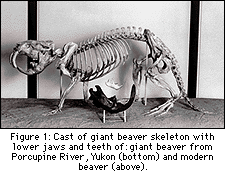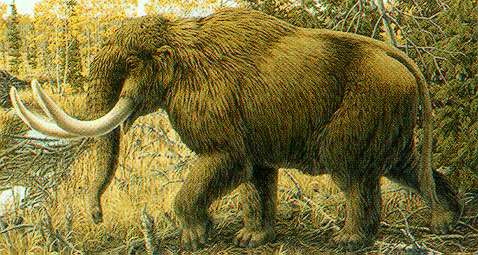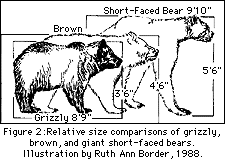
Migrations Across the Bering Land Bridge Since the land bridge's exposure 70 mya there have been many migrations of animals across the Bering Land Bridge. Migrations occurred both ways across the landbridge. Of the fossils found in eastern Beringia, 75% came from Eurasia (Morlan, 1996). During the Pleistocene, 6 mammal species moved from America to Siberia while 22 moved from Siberia to America (Hopkins, 1998). Three North American Land Mammal Ages have crossed the Bering Land Bridge in the past 5 my. These are the Blancan, the Irvingtonian, and the Rancholabrean fauna (Morlan, 1996). The Rancholabrean fauna were the Ice Age animals. Isolation of fauna in Beringia provided an important site for faunal evolution and dispersal in North America. Fauna include mammals, insects, and even parasitic worms. Did you know that North America used to populate camels?! Unfortunately, camels did not make it through the end of the last Ice Age in North America. These migrations across the Bering Land Bridge are one of the important events that determined present day fauna in North America.

Large Fauna in East and West Beringia Based on bone fossils, species of large mammals that were common to Siberia and the Alaska-Yukon Territory were the saber-toothed cat, mammoth, red deer known as wapiti, steppe bison also referred to as large-horned bison, and two species of musk-ox (West, 1998). The small horse Equus lambei was only present in West Beringia, and the woolly rhinoceros and Equus hemionus horse were only present in East Beringia (West, 1998).
Characteristics of the Rancholabrean Fauna
The Rancholabrean Fauna (also known as the Pleistocene or Mammoth Fauna) were unusually large. Compared to Holocene fauna, fauna were much more diverse. Most were herbivore grazers feeding on grass. Hooves were much smaller for travelling on firm ground. Today hooves are wider to obtain stability in the wet, tussocky, or sphagnum covered terrain of the Arctic and Subarctic. Xeric feeders (equid, proboscidian, and bovid) were replaced by the cervid mesic-adapted species which eat leaves of dycotyledons, twig tips, and lichens. Juvenile mortality was very high due to predation and the cold. Mature species had a high survival rate because of their size. (Hopkins et al, 1982)
Diversity and Size The Pleistocene fauna that we immediately think of are the dominant large grazing mammals such as the triad of woolly mammoth, horned bison, and Pleistocene horses. In fact, the size of animals during the Pleistocene were very diverse. Rodents such as lemmings and voles roamed Beringia as well. Animals that did survive the end of the last Ice Age are generally smaller today than during the Pleistocene. We immediately think of the beaver, lions, and bears.



Adaptations The most significant adaptations would be in response to the very cold temperatures of the Pleistocene. Some of the adaptations to the cold by the large hairy grazers were thick pelts, skins, and dark coloured fur. Small animals such as voles made caches of food under windswept snowdrifts for shelter.
Two Faunal Examples of Adaptations and Migrations to Beringia
Woolly MammothThe Wooly Mammoth (Mammuthus primigenius) was a very hairy animal. Their guard hair was dark and up to 90 cm long, and covered a fine underwool. Hair was moulted in the summer. Their skin was dark and the insulating fat layer was thick (up to 90 mm). They were about 3 m high at the shoulder. They feed on grass. Mammoths are known for their large tusks which may have been used to scape ice and snow off vegetation. The earliest Woolly Mammoth fossils came from Siberia and date around 150,000 ya. Adaptations include modifications to the teeth, a decrease in body size over time, and an increase in pelt thickness. These adaptations are probably in response to changes in the vegetation and cold. Woolly Mammoth are indicators of tundra, tundra-boreal forest margin, or cold loess-steppe climates that existed 90,000-10,000 ya in North America. Woolly Mammoth spread from Alaska to Ontario, and fossils date around 30,000 ya in the Yukon Territory. They became extinct here around 11,000 ya. In 1993 it was discovered that dwarf woolly mammoths lived on an Island off the coast of Siberia until around 3,500 ya. (Source: Harington, 1995 -Beringia Interpretive Centre)
Jefferson's Ground SlothThe largest fossil for a Jefferson's Ground Sloth (Megalonyx jeffersonii)was close to the size of an ox (2.5-3.0 m long). These sloths had unusually thick hair to withstand the cold, specially adapted plantigrade feet probably to facilitate movement and promote stability, specialized teeth arrangement and strong jaw muscles for chewing, and well developed collar bones and a tail to help with stability while reaching for high forage. Megalonychidae ground sloths have been around since the early Oligocene (35 mya) in South America, and Megalonyx were present 150,000 ya since the Illinoian glaciation, and around 5 mya in North America. Most ground sloths increased in size over time (probably because they spread North). Megalonyx jeffersonii made it to Alaska, the Yukon and Northwest Territories, and then spread East during the both the Sangamonian and the Pleistocene interglacial warming phases.(Source: Harington, 1993 -Beringia Interpretive Centre)
Behaviour: Modern Analogues
Understanding the behaviour of extinct fauna largely depends on finding a modern analogue. The Pleistocene Fauna has been repeatedly compared to the modern African savannah fauna. The woolly mammoth is compared to the elephant, the woolly rhinoceros to the rhinoceros, and the saiga antelope to the antelope (Elias, 1995).

